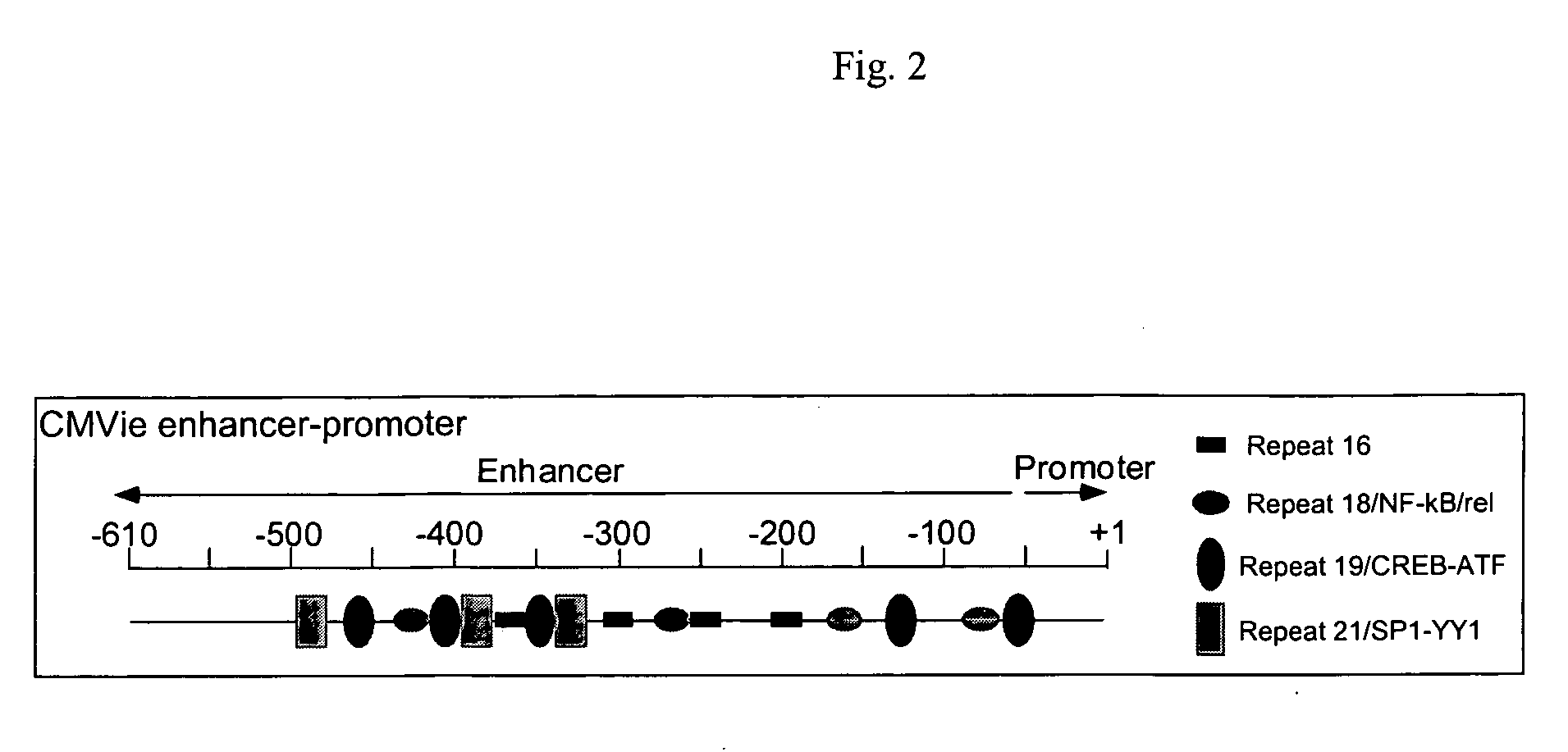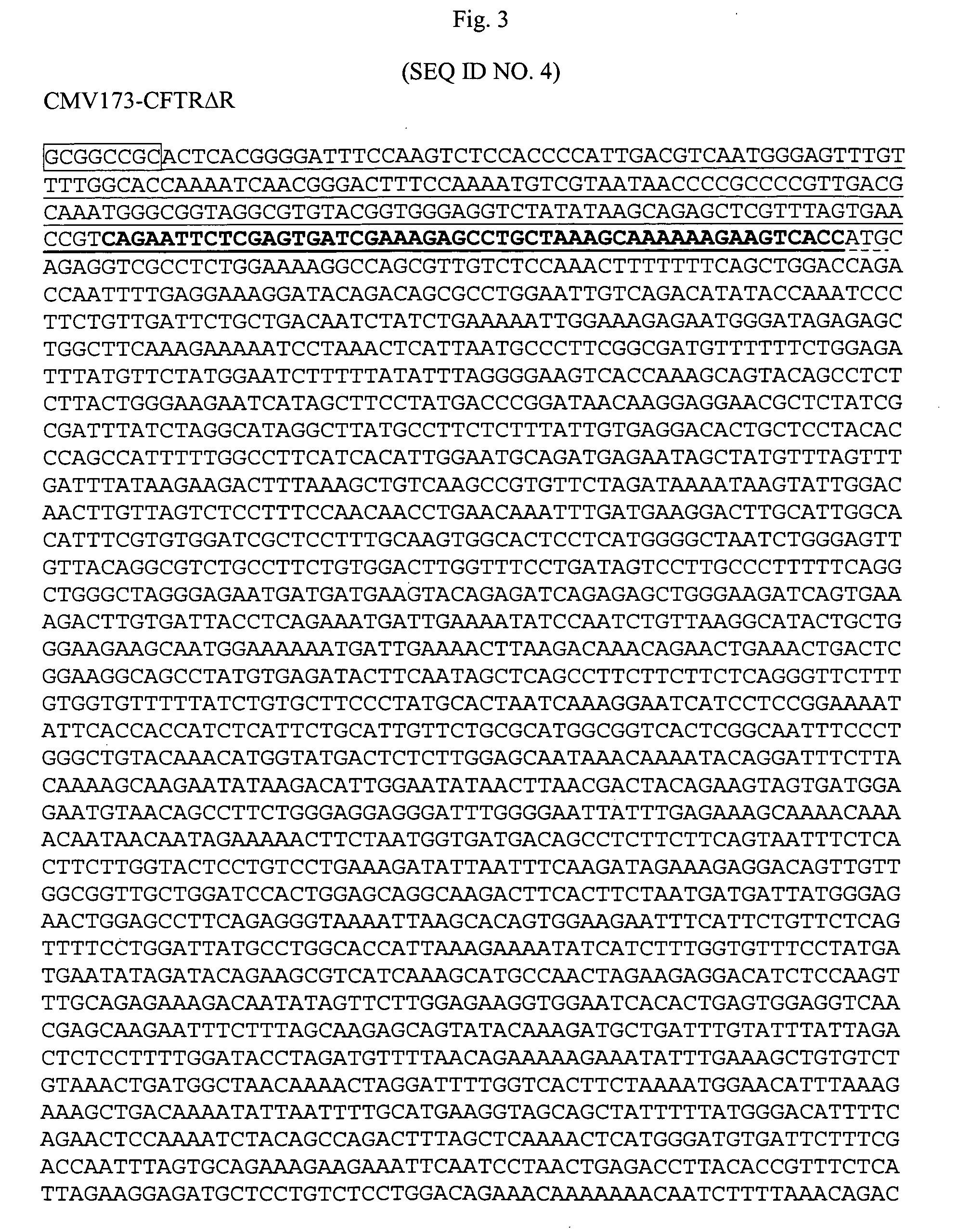Truncated CMV promoters and vectors containing same
a technology of cmv promoters and vectors, applied in the field of nuclear acids, can solve the problems of inefficient gene transfer across the apical surface of differentiated airway epithelia, inducing cell-mediated immune responses, and promoting transgene transcription
- Summary
- Abstract
- Description
- Claims
- Application Information
AI Technical Summary
Problems solved by technology
Method used
Image
Examples
example 1
Construction and Analysis of Truncated CMVie Enhancer-Promoters
[0045]FIG. 2 shows a diagram of the 610-bp human CMVie enhancer-promoter, which contains clusters of nucleotide repeats that bind specific transcription factors. Stinski, 1999, In Gene Expression Systems: Using Nature for the Art of Expression. Academic Press, New York. 1999. pp. 211-233. Coordination between these transcription factors determines promoter activity. To maintain promoter activity while reducing length, sequences that contained different combinations of these nucleotide clusters were systematically removed and inserted into a β-galactosidase reporter plasmid. The resulting plasmids then were transfected into two airway epithelial cell lines (A549 and H441) and into non-polarized, primary cultures of human airway epithelial cells by lipofectamine-mediated transfection, where promoters that were functional in airway epithelia could be identified.
[0046] The initial constructs examined were the CMVie enhance...
example 2
Effect of an Intervening Sequence on the Function of the Truncated CMVie Enhancer-Promoters
[0047] In previous studies utilizing the full-length CMVie enhancer-promoters, it was observed that the inclusion of an intron increased expression levels. Yew et al., 1997, Human Gene Therapy 8:575-584. Therefore, the effect of including the 19S / 16S intron from SV40 in the intervening sequence between the transcription and translation start sites of the 173CMV and 113CMV constructs were examined. As shown in FIG. 5, this intron did not enhance β-galactosidase activity in A549 cells, but instead slightly reduced promoter activity.
[0048] To determine how the length of the intervening sequence (IVS) between the transcriptional and translational start sites affected promoter activity, a series of IVSs of differing lengths that maintain a minimum of predicted secondary structure were examined. The IVS in our original vector was 69-bp and was a composite of a multiple cloning site and the 5′ untr...
example 3
Effect of Polyadenylation Signals on the Function of the Truncated CMVie Enhancer-Promoters
[0049] The 49-bp consensus synthetic poly(A) addition (SPA) sequence (AATAAA(22nt)GTx / Tx) has been reported to be equivalent to or better than a typical full-length poly(A) addition sequence in expression constructs. Levitt et al., 1989, Genes Dev. 3:1019-1025. To determine whether this SPA could replace the full-length 630-bp human growth hormone (hGH) poly(A) sequence present in pCMV5-β-gal, constructs containing these two alternative poly(A) signals were prepared and tested in airway epithelial cell cultures. As shown in FIG. 7, these two poly(A) addition signals yielded nearly equivalent expression levels when tested with the full-length CMVie and the 113CMV promoters. However, expression from the 173CMV promoter was reduced when the SPA was used.
PUM
| Property | Measurement | Unit |
|---|---|---|
| pH | aaaaa | aaaaa |
| length | aaaaa | aaaaa |
| nucleic acid sequence | aaaaa | aaaaa |
Abstract
Description
Claims
Application Information
 Login to View More
Login to View More - R&D
- Intellectual Property
- Life Sciences
- Materials
- Tech Scout
- Unparalleled Data Quality
- Higher Quality Content
- 60% Fewer Hallucinations
Browse by: Latest US Patents, China's latest patents, Technical Efficacy Thesaurus, Application Domain, Technology Topic, Popular Technical Reports.
© 2025 PatSnap. All rights reserved.Legal|Privacy policy|Modern Slavery Act Transparency Statement|Sitemap|About US| Contact US: help@patsnap.com



